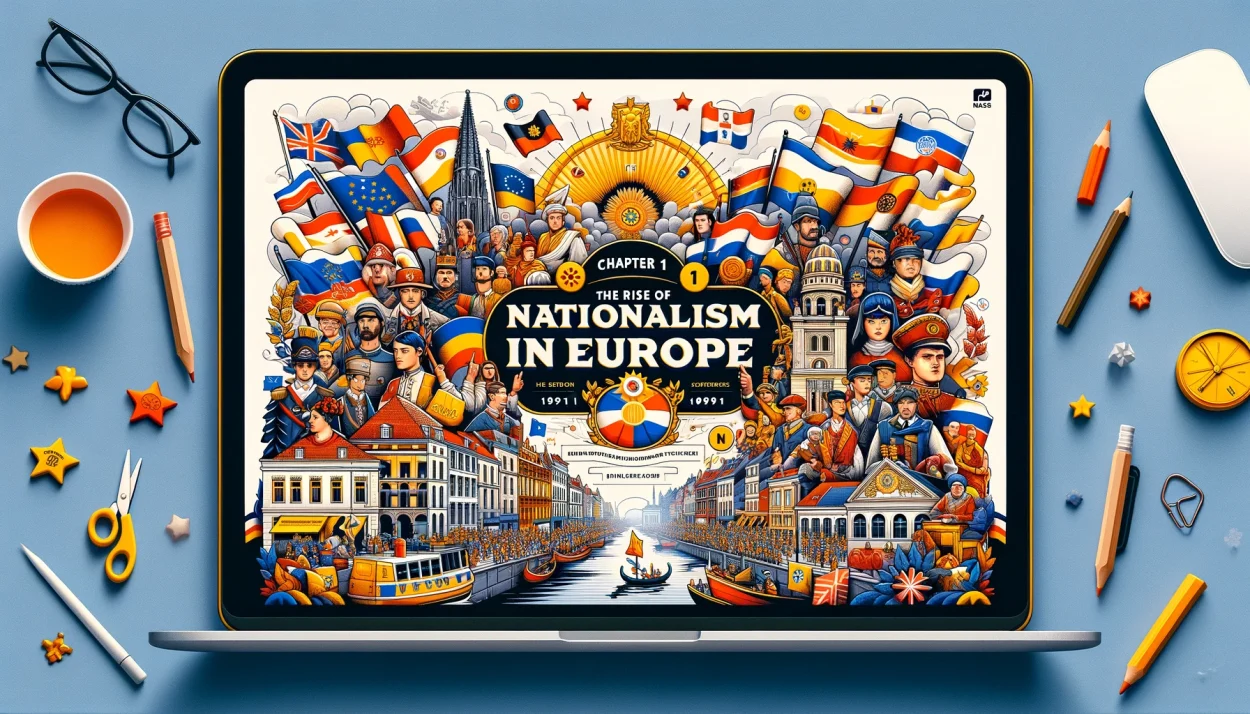
NCERT Class 10 History Chapter 1 Guide: Exploring the Rise of Nationalism in Europe – Overview, Key Dates, and FAQs

NCERT Class 10 Social Science
History: India and the Contemporary World – II
Chapter 1: The Rise of Nationalism in Europe
Abstract of the Chapter:
The first chapter of the NCERT Class 10 Social Science History textbook, “India and the Contemporary World – II,” delves into the emergence and spread of nationalism in Europe during the late 18th and 19th centuries. It traces the transformation of nationalism from a cultural sentiment into a political ideology and movement, leading to the formation of nation-states in place of the multi-ethnic empires that previously dominated Europe. The French Revolution of 1789 plays a central role in this narrative, serving as a catalyst for nationalist ideas. The chapter also explores the unification of Italy and Germany, the role of culture in creating national identities, and the impact of liberalism and conservatism on the nationalist movements.
Main Points:
- Origins of Nationalism: The concept of nationalism emerged from the desire for self-rule and the establishment of a government representing the common people’s interests and culture.
- French Revolution (1789): Marked the beginning of nationalist movements, introducing the ideas of liberty, equality, and fraternity.
- Napoleon’s Role: Spread revolutionary ideals across Europe but also led to opposition due to his imperial ambitions.
- Unification of Italy and Germany: Demonstrated the power of nationalist sentiment in unifying diverse regions under a single national identity.
- Cultural Nationalism: The role of language, history, and culture in fostering a sense of national unity.
Important Years:
- 1789: French Revolution begins.
- 1815: Congress of Vienna, attempting to restore pre-revolutionary order.
- 1861-1870: Unification of Italy.
- 1871: Unification of Germany.
Points to Remember:
- Nationalism was influenced by romanticism, which emphasized common history, language, and traditions.
- The Zollverein, a customs union, played a critical role in German unification by promoting economic unity.
- Figures like Giuseppe Garibaldi in Italy and Otto von Bismarck in Germany were instrumental in their respective countries’ unification.
- The struggle for nationalism was not only against foreign rule but also against the conservative order within societies.
25 Small Questions and Answers:
- What is Nationalism?
A political ideology that advocates for the sovereignty of people based on shared culture, history, and identity. - What sparked the French Revolution?
The demand for representation and equality under the law. - Who was Napoleon Bonaparte?
A French military leader who spread revolutionary ideas across Europe. - What was the Congress of Vienna?
A conference held in 1815 to restore the pre-revolutionary monarchical order. - What is the Zollverein?
A German customs union formed to promote economic unity and facilitate trade. - Who were the key figures in the unification of Italy?
Giuseppe Garibaldi and Count Camillo di Cavour. - When did Germany unify?
In 1871, under the leadership of Otto von Bismarck. - What role did culture play in nationalism?
It helped foster a sense of common identity and unity among people. - How did liberalism influence nationalism?
By advocating for freedom, equality, and national self-determination. - What was the impact of the French Revolution on Europe?
It inspired nationalist movements and the demand for democratic governance. - Define Romanticism in the context of nationalism.
A cultural movement that emphasized emotion, history, and national folklore. - What was the significance of national symbols and anthems?
They unified people and inspired national pride. - How did economic factors contribute to nationalism?
Economic interests, such as trade and industry, encouraged national unity for better prosperity. - What was the role of technology in the spread of nationalist ideas?
The printing press and newspapers facilitated the dissemination of nationalist thought. - How did nationalism affect the map of Europe?
It led to the formation of nation-states and redrew political boundaries. - What challenges did multi-ethnic empires face with the rise of nationalism?
Nationalist movements threatened their existence and led to demands for autonomy. - How did the concept of a “nation-state” differ from the previous political order?
Nation-states were based on the sovereignty of the people rather than the divine right of kings. - What was conservative reaction to nationalism?
Conservatives opposed radical change and sought to preserve traditional social hierarchies. - How did nationalism impact the Balkans?
The region became a hotbed of nationalist tension, contributing to the outbreak of the First World War. - What was the role of women in nationalist movements?
Women participated actively but often remained marginalized in the political achievements of these movements. - How did nationalism influence colonial regions?
It inspired colonized peoples to fight for independence and self-determination. - What was the main outcome of the German unification?
The establishment of the German Empire under Prussian leadership, significantly altering European power dynamics. - Why was the unification of Italy significant?
It marked the consolidation of various Italian states into a single nation, promoting Italian culture and language. - How did the French Revolution influence the idea of citizenship?
It introduced the concept of civic nationalism, where citizenship was based on participation in the state rather than ethnicity. - What was the impact of nationalism on global conflicts?
Nationalist fervor often exacerbated international tensions, leading to conflicts like World War I.